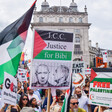26 November 2013
The Palestine Center and the Institute for Palestine Studies hosted in Washington, DC last week a fascinating presentation on Palestinians in Latin America by Dr. Cecilia Baeza, postdoctoral fellow at the Institute of International Relations of the University of Brasilia.
Latin America is home to the largest Palestinian population outside the Arab world, numbering more than half a million, but very little has been written about Palestinian communities there. Dr. Baeza’s presentation gives an overview of this history, starting with the waves of immigration by Palestinian Christian merchants at the end of the Ottoman empire, peaking between 1900-1930, before the ethnic cleansing and dispossession of Palestine in 1948.
“Palestinians in Latin America do not easily fit into the national narrative shaped by the refugee experience,” Dr. Baeza explains. “In fact, Palestinian historiography has long seemed uninterested in this diaspora which doesn’t meet the criteria of Palestinian-ness as defined by the political necessities of a national discourse centered on the state of dispossession, denial and statelessness of the refugees.”
“Turcos”
The movement of immigration of Palestinians to Latin America was a result of new European tourism to the Holy Land. Local artisans who made religious souvenirs emerged as a new class of Christian merchants, some of whom traveled to the US to attend international fairs and then went southward.
Ottoman citizens such as these Palestinian migrants were labeled as “Turcos” because of their Ottoman passports, and this term became a synonym for their trade as peddlers.
“Turcos” suffered from ethnic discrimination but their work was lucrative. Immigrants who accumulated wealth and returned to their hometowns in Palestine encouraged others to follow in their footsteps. Conflict and the deteriorating economic situation after the First World War also caused some families to send their sons abroad.
Palestinian immigrant merchants with capital, as opposed to land owners, would become among the new partners of Latin American state development, founding textile factories and investment banks.
Meanwhile, the dispossession of Palestine in 1948 reinforced the idea of non-return to the homeland.
Palestinian figures in Latin America would play prominent roles in politics, on both the left and the right during the tumultuous 1970s and ’80s.
Self-identity
Dr. Baeza also discusses how Palestinians in Latin America have self-identified, as well as their relationship with Palestine.
The first immigrants from Palestinian cities identified with their hometown, greater Syria, their religion and their Arab-ness.
More overt nationalist identity emerged with the British mandate of Palestine, whose policies made it harder for migrants to come from and go to the homeland, prompting them to organize to protest restrictions on their entry to Palestine.
“At the end of the ’30s we have a population who increasingly claimed its belonging to the Palestinian nation while they were more than ever intended to settle in their host countries,” Dr. Baeza explained.
Over time, the Palestinian population in Latin America did lose its capacity to read and write in Arabic, and the ethnic press covering developments in Palestine was published in Spanish.
Palestine Liberation Organization
The United Nations’ recognition of the Palestine Liberation Organization in 1974 allowed it to open up Palestine information offices across South America and politicized some in the diaspora, while some Palestinian elites there believed the PLO to be subversive.
Another turning point was the 1982 massacre in the Sabra and Shatila refugee camps in Beirut, causing Palestinians in Chile to organize in solidarity with their brethren in Lebanon.
The Palestinian movement has become professionalized in more recent years, with business associations’ publications and broadcast channels serving as the main outlets for dissemination of news on Palestine.
Young Latin Americans of Palestinian descent still feel connected to Palestine, and many travel there even though they have no known relatives there. However, this is made difficult as the Israeli authorities discriminate against travelers with Palestinian ancestry.
There is additional rich information given by Dr. Baeza during the question and answer session after her presentation, and she touches on the relationship between Israel and repressive regimes in South America.






Comments
Closer to 1 million Palestinians in LA
Permalink Deïr Yassin replied on
There are between 450.000 and 500.000 of Palestinian descent in Chile alone, another 200.000 at least in Honduras (including a former president), more than 100.000 in Mexico.
Concerning the political integration: during the 2004 presidential election in El Salvador, conservative Elias Antonio Saca, from the well-known Saca family from Bethlehem, defeated Shafik Handal, former guerillero, a founding member of the Farabundo Marti National Liberation Front, also of Palestinian descent.... and from Bethlehem too.
Here's a young, fourth generation Argentinian of Palestinian descent, Lucas Rojana, reciting a poem by Mahmoud Darwish "Passers Between the Passing Words". As he says himself in the introduction: 'the Zionists were wrong about the old ones dying, and the young ones forgetting'.
www.youtube.com/watch?v=lsMmcx...
! Hasta la victoria siempre !
Thanks
Permalink saleh Abdel Jawad replied on
thanks claire for summaraizing Cecelia's presentation